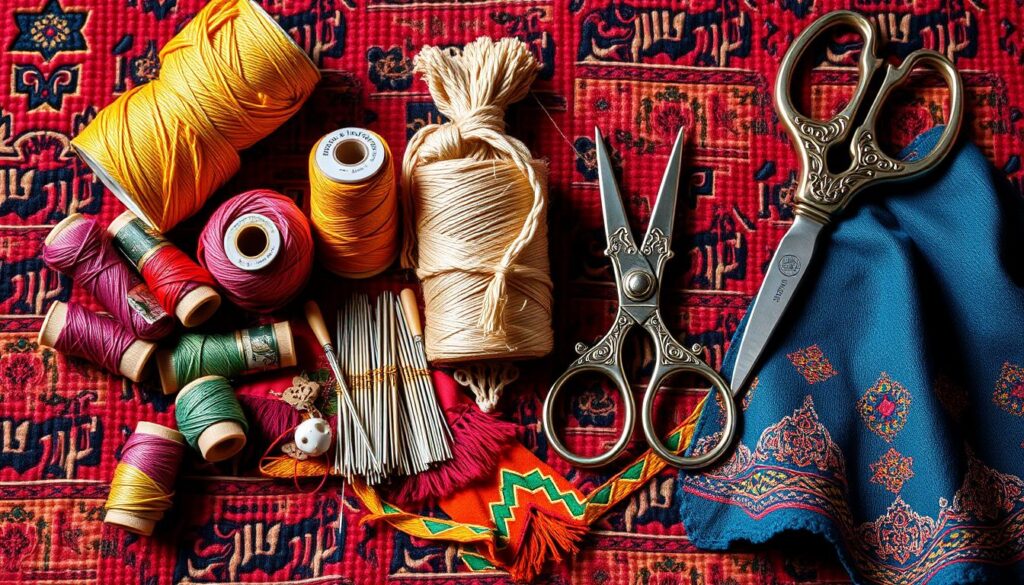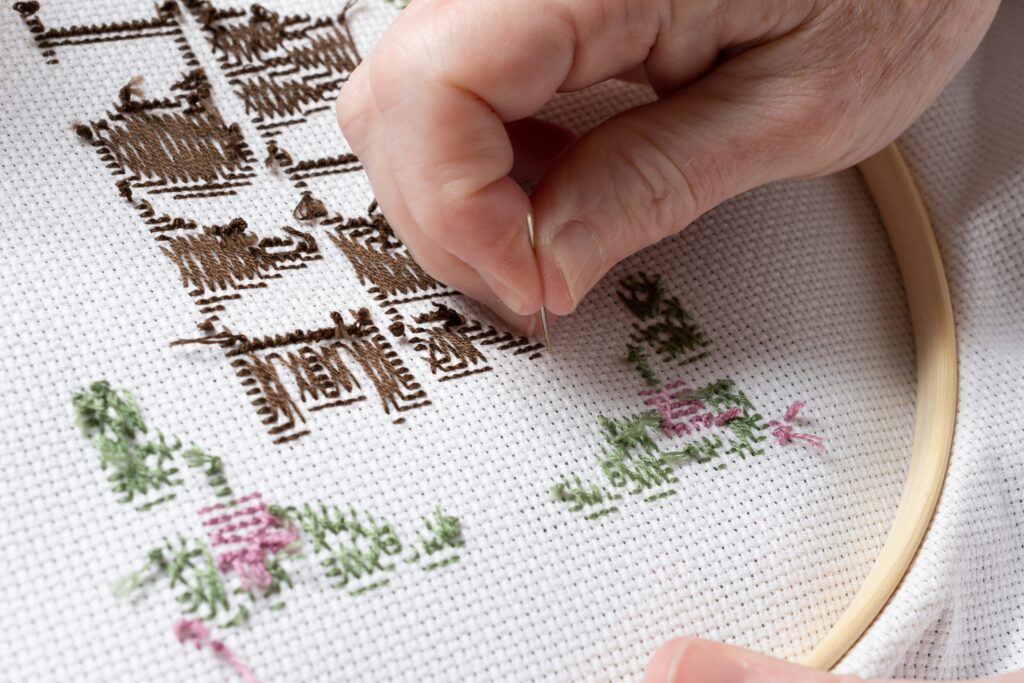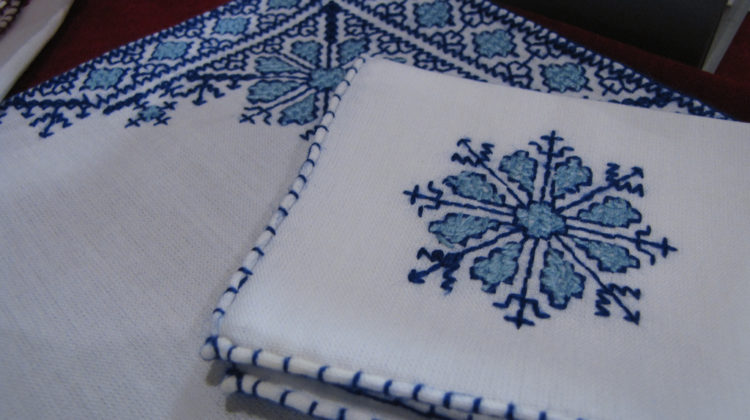Every stitch tells a story. When my fingers first touched a Moroccan textile, I felt a deep connection. Traditional Moroccan embroidery is more than just decoration. It’s a way to share stories through skill and culture.
Moroccan embroidery’s history is a mix of art and tradition. It spans from Marrakech’s markets to Berber villages. Each piece shows the bond between the maker, the design, and the story.
Exploring traditional Moroccan embroidery is like a colorful journey. Artisans turn simple fabrics into amazing pieces. They keep alive techniques that have been passed down for years.
Key Takeaways
- Moroccan embroidery represents a deep cultural storytelling tradition
- Techniques reflect centuries of artistic and historical influences
- Each embroidered piece connects past and present
- Craftsmanship involves complex skills and intricate patterns
- Embroidery serves as a living art form in Moroccan culture
Origins and Historical Evolution of Moroccan Embroidery

The history of Moroccan embroidery is rich and complex. It shows the deep traditions of North African craftsmanship. It also shows the creative spirit of the people.
Moroccan embroidery started with a mix of local traditions and outside influences. The Berber communities were at the beginning. They created advanced textile techniques that shaped the art.
Ancient Berber Influences
Berber women were key in creating unique embroidery styles. Their needlework told stories of community, survival, and identity. Geometric patterns and symbols were important, passed down through generations.
Islamic Artistic Heritage
The Islamic tradition changed Moroccan embroidery a lot. Geometric designs, inspired by math and spirituality, became key. Calligraphy and patterns showed the beauty of Islamic art.
Cultural Exchange Along Trade Routes
Trade routes brought new techniques and designs to Morocco. Silk roads and sea routes introduced exotic threads and colors. This made the embroidery art rich and always changing.
“Embroidery is not just decoration, but a living narrative of cultural interconnection and artistic expression.” – Moroccan Textile Historian
Essential Tools and Materials for Moroccan Embroidery

Moroccan embroidery starts with the right tools and materials. It needs precision and careful preparation. Artisans pick materials that show off Moroccan textile design’s rich culture.
“In every thread lies the soul of Moroccan craftsmanship” – Moroccan Textile Artisan
The base of Moroccan embroidery is choosing top-notch fabrics. Silk, linen, and cotton are favorites, each with its own special qualities. Silk shines, while linen is strong and textured.
| Material | Characteristics | Best Used For |
|---|---|---|
| Silk | Lustrous, delicate | Elegant garments, decorative pieces |
| Linen | Strong, textured | Traditional wall hangings, tablecloths |
| Cotton | Versatile, breathable | Everyday clothing, accessories |
Key tools for Moroccan embroidery include special needles, hoops, and quality threads. Copper or wooden frames keep fabric tight. Fine needles make detailed stitches possible.
Artisans say to spend on the best materials. The quality of threads and fabrics affects the artwork’s look and life. Natural dyes and hand-spun threads keep the true Moroccan embroidery alive.
Traditional Moroccan Embroidery Techniques and Methods

Moroccan embroidery is a rich mix of art and culture. It uses old techniques and tells stories through fabric. This craft has been passed down through generations, keeping North African textile traditions alive.
Artisans turn simple fabrics into works of art with special stitches. These stitches need skill, patience, and a deep understanding of culture.
Basic Stitch Formations
Traditional Moroccan embroidery starts with basic stitches. These stitches are the building blocks of their detailed designs:
- Running stitch
- Backstitch
- Chain stitch
- Cross-stitch
Advanced Pattern Construction
Advanced embroidery involves complex layers and precise shapes. Skilled artisans create intricate patterns. These patterns show math skills and carry cultural meanings.
| Technique | Complexity Level | Cultural Significance |
|---|---|---|
| Geometric Layering | Advanced | Berber Mathematical Traditions |
| Symbolic Pattern Weaving | Expert | Spiritual Narrative Representation |
Regional Variation Techniques
Every Moroccan region has its own embroidery style. From the coast to the mountains, each area’s techniques show its unique heritage.
“Embroidery is not just craft—it’s a language of cultural memory” – Traditional Moroccan Artisan
To understand Moroccan embroidery, you must appreciate its cultural depth. Each stitch and pattern tells a story.
Understanding Color Theory in Moroccan Needlework

Colors bring Moroccan embroidery to life, turning simple threads into stories. Traditional designs show a deep understanding of color. This is rooted in culture and art.
The colors in Moroccan needlework show rich traditions. Artisans pick colors that mean more than just looks. Warm terracottas stand for strength, deep blues for spiritual protection, and greens for Islamic culture.
“In Moroccan embroidery, every color tells a story waiting to be understood.” – Moroccan Textile Artisan
Natural dyes are key in authentic designs. Craftspeople get colors from local plants and minerals. Saffron makes golden yellows, pomegranate skins create deep browns, and indigo makes stunning blues.
| Color | Cultural Meaning | Traditional Source |
|---|---|---|
| Blue | Protection | Indigo Plants |
| Red | Vitality | Madder Root |
| Green | Spiritual Growth | Mint Leaves |
Today, Moroccan embroidery artists mix old wisdom with new views. Their work shows color’s power in sharing culture.
Popular Moroccan Embroidery Patterns and Motifs

Moroccan embroidery patterns are a rich art form. They mix cultural symbols with detailed designs. These motifs share stories of tradition, spirituality, and artistry through visual tales.
Geometric Designs: Mathematical Precision
Geometric designs are key in Moroccan embroidery. They come from Islamic art traditions. These patterns show off math skills with shapes that fit together perfectly.
Artisans make stunning symmetrical designs. They use triangles, squares, and stars. These designs show deep spiritual and philosophical ideas.
Floral Patterns: Nature’s Inspiration
Nature inspires many Moroccan embroidery motifs. Flowers, leaves, and plants turn fabric into living art. These designs use soft curves and shapes that stand out against geometric patterns.
Symbolic Elements: Cultural Significance
Symbolic elements in Moroccan embroidery hold deep cultural meanings. The Hand of Fatima means protection. Animals in the designs tell stories of the spirit and society.
These symbols make embroidery more than just decoration. They are a powerful way to share stories and ideas.
| Pattern Type | Cultural Meaning | Key Characteristics |
|---|---|---|
| Geometric Designs | Spiritual Harmony | Symmetrical Shapes |
| Floral Patterns | Natural Connection | Organic Curves |
| Symbolic Elements | Cultural Storytelling | Metaphorical Representations |
“In every thread, a story is woven; in every pattern, a culture is revealed.” – Moroccan Textile Arts Collective
Regional Styles and Their Distinctive Features

Moroccan embroidery styles show a rich mix of cultures. Each area has its own special traits that share deep stories of art. From Fez’s detailed designs to Rabat’s bold patterns, these textiles highlight Morocco’s rich textile history.
Fez is known for its fine silk threads and exact geometric shapes. Its embroidery often has zellij-like designs, showing math and spiritual meaning. The artists here turn fabric into detailed art with their skillful needlework.
Rabat has a different style, with bright colors and big designs. Its embroidery uses bold reds, blues, and greens. This reflects Rabat’s lively culture by the sea.
“Each stitch tells a story of tradition, culture, and artistic inheritance.” – Moroccan Textile Artisan
Meknes and Tetouan also add their own special views to Moroccan embroidery. Meknes is famous for its detailed flower patterns. Tetouan’s embroidery is influenced by Andalusian art.
| Region | Distinctive Style | Typical Colors |
|---|---|---|
| Fez | Geometric Precision | Silk Threads, Neutral Tones |
| Rabat | Bold Patterns | Vibrant Reds, Blues, Greens |
| Meknes | Floral Designs | Soft Pastels |
| Tetouan | Andalusian Influences | Rich, Warm Tones |
These different styles show the deep and complex beauty of Moroccan embroidery. They keep cultural stories alive through detailed textile art. This art still inspires many designers and artists around the world.
Step-by-Step Guide to Basic Moroccan Stitches
Learning traditional Moroccan embroidery takes time and effort. This guide will show you how to do beautiful Moroccan embroidery stitches. These stitches have been loved for many generations.
Preparation Techniques
First, get your materials ready. Choose a light fabric like cotton or linen for easy stitching. Use an embroidery hoop to keep your fabric tight and smooth.
Foundation Stitches
Mastering basic stitches is key to Moroccan embroidery. Start with these essential techniques:
| Stitch Name | Difficulty Level | Characteristic |
|---|---|---|
| Fez Stitch | Beginner | Geometric and precise |
| Rabat Stitch | Intermediate | Flowing and decorative |
| Meknes Stitch | Advanced | Complex and intricate |
Finishing Methods
Finishing your embroidery is important. Tie off threads on the back, trim excess, and press your work. This makes it look professional.
“In Moroccan embroidery, every stitch tells a story of cultural heritage and artistic expression.” – Traditional Artisan Wisdom
Practice and patience are key to perfecting these beautiful traditional moroccan embroidery techniques.
Modern Applications of Traditional Techniques
Moroccan embroidery art has grown beyond its old ways. It now shines in today’s designs. Designers around the world mix old traditions with new styles.
Fashion designers love these detailed techniques. They use them in fancy clothes and everyday wear. Brands like Valentino and Dior show off Moroccan stories through their embroidery.
“Traditional techniques are not relics—they are living art forms that continue to inspire and transform design,” says textile historian Elena Rodriguez.
New tech has made Moroccan embroidery reach more people. Digital machines make complex patterns with great accuracy. This lets artists do more work without losing the small details.
| Design Application | Contemporary Usage |
|---|---|
| Fashion | High-end clothing, accessories |
| Home Decor | Throw pillows, wall hangings |
| Digital Media | Graphic design, textile printing |
Interior designers use Moroccan embroidery in modern homes. They make beautiful stories that mix old skills with new looks. The versatility of these techniques allows for seamless adaptation across various creative domains.
Preservation and Care of Moroccan Embroidery
Keeping Moroccan embroidery safe needs special care and knowledge. Each piece is a treasure from a rich culture. It must be kept in top shape to stay beautiful and meaningful.
Intelligent Storage Solutions
Storing Moroccan embroidery right is key. Experts say to use acid-free boxes for them. Keep them away from sunlight and very hot or cold places.
Use acid-free paper to wrap them. This helps avoid damage to the fabric and keeps colors bright.
Gentle Cleaning Approaches
Cleaning these textiles needs to be done carefully. Use a vacuum with a mesh screen to get rid of dust. This way, you won’t hurt the stitches.
If you need to clean deeper, get a pro. They know how to clean without harming the fabric.
Expert Restoration Strategies
Fixing Moroccan embroidery needs special skills. Only experts should do small repairs. They know how to fix it right.
Professional help keeps the embroidery looking like new. It also keeps its true beauty alive.
“Each thread tells a story, and preservation is about protecting that narrative.” – Moroccan Textile Preservation Expert
By following these steps, you can keep your Moroccan embroidery in great shape. This way, it will last for years to come.
Incorporating Moroccan Embroidery in Contemporary Design
Moroccan embroidery patterns bring a burst of color to modern spaces. They mix old-world craftsmanship with today’s designs. This blend makes homes and offices tell stories of art and culture.
Designers are finding new ways to use moroccan embroidery in many styles. It goes from simple living rooms to wild bedrooms. Things like pillows, wall art, and furniture become ways to show off cultural stories.
“Moroccan embroidery bridges centuries of artistic tradition with contemporary design language” – Design Quarterly
Fashion lovers are also using moroccan embroidery in clothes and accessories. Bags, jackets, and shoes now show off Morocco’s art with special designs.
Choosing moroccan embroidery for today’s spaces is all about colors and looks. Simple backgrounds make the embroidery pop. But, bold colors make a big statement.
| Design Style | Embroidery Integration |
|---|---|
| Minimalist | Subtle accent pieces |
| Bohemian | Multiple layered textiles |
| Modern | Geometric pattern focus |
Moroccan embroidery keeps growing, giving designers endless ways to be creative. It keeps the old traditions alive while making new designs.
Conclusion
The world of traditional Moroccan embroidery is a journey through culture and art. It’s more than just decoration. It tells the story of Moroccan identity and creativity.
Each stitch connects today’s artists with those of the past. They have kept these art forms alive.
Moroccan embroidery art is changing, blending old with new. Designers use these ancient techniques in modern ways. This makes the art appealing to people all over the world.
It’s seen in fashion and home decor. This shows how timeless and important it is.
Keeping this craft alive needs everyone’s help. Museums, schools, and workshops are key. They teach and celebrate these embroidery methods.
Supporting local artists is crucial. It helps keep this art form alive for future generations.
The future of Moroccan embroidery is bright. It will keep its essence while reaching more people. This will show the world the beauty of Moroccan craftsmanship.
